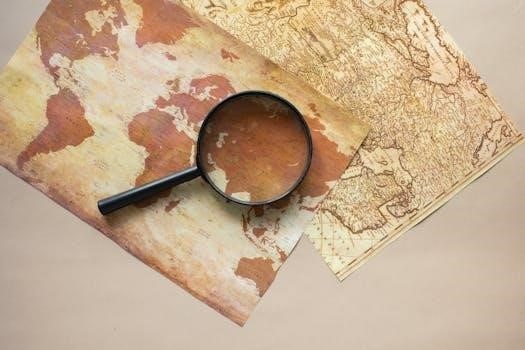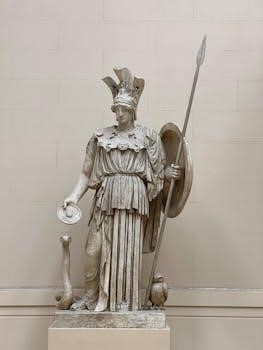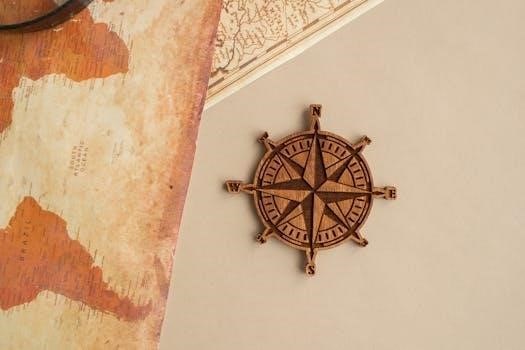Antique hunting offers a fascinating journey into history, culture, and craftsmanship. It’s a rewarding hobby where enthusiasts connect with the past, preserving valuable pieces. Beginners find themselves captivated by the allure of discovering treasures. It’s a world where each piece tells a story.

What is Antique Hunting?
Antique hunting is the art of searching for and collecting vintage and antique items, a journey through history where each find tells a story. It’s more than just shopping; it’s about uncovering pieces that connect us to the past. The term “antique” typically refers to items over 100 years old, while “vintage” generally describes items between 20 and 100 years old. However, in a broader sense, both categories offer unique items. It involves visiting antique shops, fairs, and estate sales, hoping to discover hidden gems. This process requires patience, knowledge, and a keen eye. It’s not about finding the most expensive items, but about finding items that resonate with you and your interests. The search itself becomes an adventure. It is a pursuit that blends historical appreciation with the thrill of discovery, making it a captivating hobby for many.
Why Collect Antiques?
Collecting antiques is a rewarding hobby that allows individuals to delve into history, culture, and craftsmanship. It’s a way to connect with the past and preserve valuable pieces of art. For many, it’s about the thrill of the hunt, the excitement of discovering a unique item with a story. Antiques can add old-world charm to your home, creating a unique and personalized space. Unlike modern mass-produced items, each antique has its own history and character. Collecting can also be an educational journey, teaching you about different periods, styles, and artisans. It also allows enthusiasts to connect with history and preserve valuable pieces. Furthermore, it can be a fulfilling hobby that provides both aesthetic pleasure and intellectual stimulation. It’s a way to own a piece of history and appreciate the artistry of bygone eras. Ultimately, the reasons for collecting are as diverse as the collectors themselves, driven by passion, curiosity, and a love for the unique.

Getting Started with Antique Hunting
Embarking on an antique hunting journey requires careful preparation. Researching different types of antiques is essential. Setting a budget is also crucial for a successful start. Start small with a specific category or period to avoid being overwhelmed.
Research and Preparation
Before diving into the world of antique hunting, thorough research and preparation are paramount. Begin by identifying the specific types of antiques that pique your interest. Are you drawn to vintage furniture, antique jewelry, or perhaps historical documents? Understanding your preferences will help narrow your focus and make your searches more efficient. Once you’ve determined your area of interest, delve into learning about its history, styles, and common characteristics.
Explore books, articles, and online resources to familiarize yourself with the hallmarks of authenticity. Knowledge is your greatest tool, enabling you to distinguish genuine antiques from reproductions. Furthermore, research the current market value of items you’re interested in. This will help you to recognize a good deal and avoid overpaying. Familiarize yourself with the various places to find antiques, such as antique stores, flea markets, and online auctions. Learning about the unique offerings of each venue will guide you to the best sources. Preparation also involves making a list of what you’re looking for, as this can prevent you from feeling overwhelmed and making impulse purchases.
Setting a Budget
Establishing a budget is a crucial step in responsible antique hunting. It helps prevent overspending and ensures your passion remains a sustainable hobby. Before embarking on your treasure hunt, determine how much you’re comfortable spending on antiques, whether it’s per outing or within a specific time frame. Be realistic about your financial limitations, and factor in additional costs like transportation, restoration, and potential storage. Consider whether you’re looking to build a collection or simply find unique pieces for your home, as this will influence your spending habits.
It’s also wise to set a range of prices that you’re willing to pay for specific types of antiques. This helps you to make informed decisions when you find something you love, and prevents you from making impulse purchases that exceed your budget. Remember that the value of antiques can fluctuate, so be cautious about overspending on items that may not appreciate in value. Adhering to a budget is essential for a fulfilling and enjoyable experience. It allows you to focus on the thrill of discovery rather than the stress of financial strain, and encourages patience and careful selection;

Key Strategies for Successful Antique Hunting
Successful antique hunting requires a blend of knowledge, patience, and strategy. Knowing what you seek, where to search, and how to evaluate items are key. Understanding authenticity and condition will guide you toward wise purchases. These are crucial for a fruitful quest.
Knowing What You’re Looking For
Before embarking on your antique hunting adventure, it’s crucial to have a clear idea of what you are seeking. This involves more than just a general interest; it requires research and a focused approach. The world of antiques is vast, encompassing everything from vintage furniture and delicate glassware to rare books and unique collectibles. Begin by identifying the types of antiques that genuinely pique your interest. Are you drawn to the elegance of antique silver, the charm of vintage toys, or the historical significance of old maps? Your personal preferences should guide your initial explorations. Once you’ve determined your preferred categories, delve deeper. Investigate the specific characteristics, styles, and periods associated with these items. For instance, if you admire antique furniture, research the different styles, such as Victorian, Art Deco, or Mid-Century Modern. Understanding the nuances of each style will help you identify authentic pieces and appreciate their unique qualities. By having a focused approach, you’ll navigate the diverse world of antiques with greater confidence, increasing your chances of finding truly exceptional items that resonate with your tastes and interests.
Where to Find Antiques
The quest for antiques can lead you to various exciting locations. Antique shops and markets are popular starting points, offering a curated selection of items from different eras. These venues provide a comfortable environment for browsing, often with knowledgeable vendors who can offer insights into the pieces. Estate sales and auctions are also excellent places to uncover hidden gems. Estate sales, typically held when a property is being cleared out, can yield a diverse range of antiques at competitive prices. Auctions, on the other hand, offer the thrill of bidding and the potential for finding rare and unique pieces. Don’t overlook flea markets and garage sales, where you might stumble upon unexpected treasures at affordable prices. These less formal settings often require a bit more digging, but the rewards can be significant. Online platforms provide another avenue for antique hunting, with websites dedicated to vintage and antique items. These digital marketplaces offer convenience and a vast selection, but it’s crucial to carefully verify authenticity and condition before making a purchase. By exploring these various venues, you’ll expand your horizons and increase your chances of discovering the perfect antique.
Authenticity and Condition
Determining the authenticity and condition of an antique is crucial for any collector. A true antique is typically defined as an item over 100 years old, while vintage items are generally those between 20 and 99 years old. However, this distinction is not always clear cut. When examining an item, pay close attention to its construction, materials, and markings. Researching these details can help you identify genuine antiques and avoid reproductions. The condition of an antique significantly impacts its value. Look for signs of wear, damage, or restoration. Minor imperfections might be acceptable, especially in older pieces, but significant damage can greatly reduce the value. Check for cracks, chips, repairs, or replaced parts. Don’t hesitate to ask questions about the item’s history and condition. Reputable dealers should be transparent about any flaws or alterations. Being able to distinguish between the authentic and the reproduction is a skill that develops over time. This process requires study, a keen eye, and the ability to assess the quality of craftsmanship. You must always check the authenticity and condition.

Advanced Tips for Antique Hunters
For seasoned antique hunters, advanced strategies are key. Effective negotiation, identifying hidden gems, and understanding market trends are essential. These skills allow collectors to find unique pieces and maximize their collection’s value. It’s about refining the art of the hunt.
Negotiation Strategies
Mastering negotiation is crucial for successful antique hunting. Begin by researching the item’s market value to know its worth. Always approach with a respectful and friendly attitude, creating a positive atmosphere. Don’t be afraid to ask questions about the item’s history and condition; this shows genuine interest. Identify any flaws or damage, as this can justify a lower price. Start with an offer below your maximum, but be prepared to meet in the middle. Be patient and willing to walk away if the price isn’t right. Sometimes, returning later might lead to a better deal. It’s also wise to bundle multiple items for a bulk discount. Cash can be a powerful negotiation tool. Remember, the goal is to secure a fair price for both parties. Successful negotiation is about building a respectful relationship and finding a win-win solution. It is an art, that is perfected with experience, never giving up, but always being strategic;
Identifying Hidden Gems
Discovering hidden gems is a thrilling aspect of antique hunting. Look beyond the obvious; explore corners, shelves, and less-trafficked areas. Pay attention to items that might be overlooked by others. Research specific makers’ marks or unique features that indicate value. Examine pieces closely for signs of age and authenticity; sometimes the best finds are in unexpected places. Be open to items that aren’t in perfect condition, as they can often be restored. Look for quality craftsmanship and materials that stand out. Develop a keen eye for detail and don’t be afraid to ask questions about a piece’s origin or story. Sometimes, hidden gems are not immediately apparent. Visit shops and markets frequently, as new items are constantly being added. Consider attending estate sales for unique opportunities, and always trust your intuition when something catches your eye. Hidden gems are often found when you least expect it, with diligent searching.
